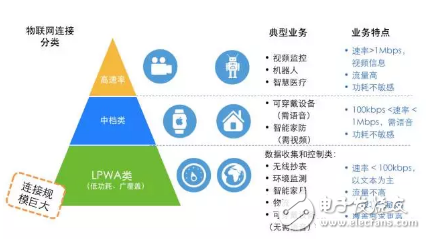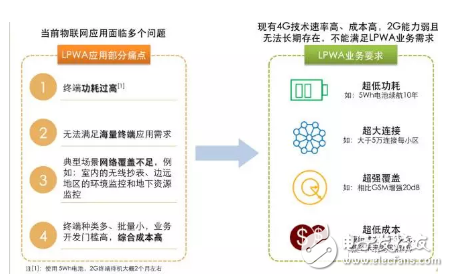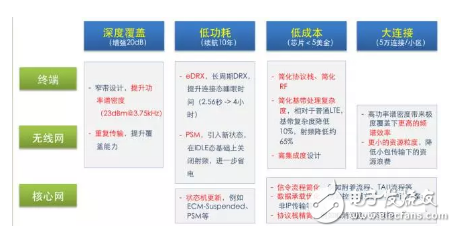In September 2015, the global communications industry reached a consensus on the formation of a low-power, wide-area coverage (LPWA) IoT standard, and the NB-IoT standard came into being. This year, with the completion of the test of NB-IoT, it officially entered the commercial stage, and the industry's attention and discussion on it is gradually heating up.

It is predicted that in 2016, 6.4 billion IoT devices will be connected to the network every day, and 5.5 million devices will be connected to the network. One of the foundations of the “Internet of Everything†is the transmission of data, and the data transmission capabilities of different IoT services. Real-time has different requirements.
According to the different transmission rates, IoT services can be distinguished by high, medium and low speed:
• High-rate services : mainly use 3G and 4G technologies, such as in-vehicle IoT devices and surveillance cameras, and the corresponding business features require real-time data transmission;
• Medium-rate services : mainly use GPRS technology, such as lockers in residential quarters or supermarkets, which are frequently used but not used in real time. The requirements for network transmission speed are far less than high-speed services;
• Low-rate services : The industry has classified the low-rate business market into the LPWAN (Low Power Wide Area Network) market, a low-power WAN. At present, there is no corresponding cellular technology, and in most cases, it is supported by GPRS technology, which brings about a problem of high cost and low penetration of low-rate services.
That is to say, the current low-rate business market is in urgent need of development, and the low-speed business market is actually the largest market, such as fire extinguishers in buildings, various monitors used in scientific research, and the frequency of such devices in life is very low. But the total number of collections is considerable, and the collection of these data is used for various purposes, such as improving the configuration of urban equipment.
NB-IoT is a new narrowband cellular communication LPWAN (Low Power Wide Area Network) technology that can help us solve this problem.

As a technology applied in low-rate services, the advantages of NB-IoT are not difficult to imagine:
Strong links : In the case of the same base station, NB-IoT can provide 50-100 times more access than existing wireless technologies. One sector can support 100,000 connections, supporting low latency sensitivity, ultra-low device cost, low device power consumption, and optimized network architecture. For example, due to bandwidth limitation, operators only open 8-16 access ports for each router in the home, while a family often has multiple mobile phones, laptops, and tablets. In the future, it is necessary to realize the whole house intelligence. The need for networking across hundreds of sensing devices has become a daunting challenge. And NB-IoT is enough to easily meet the needs of a large number of devices in the future smart home networking.
High coverage : NB-IoT has a strong indoor coverage capability, which is 20dB higher than LTE, which is equivalent to an increase of 100 times coverage area. Not only can it meet the wide coverage needs of rural areas, but also for applications such as factory areas, underground garages, and manhole covers that require deep coverage. Take the manhole cover monitoring as an example. In the past, the GPRS method required an antenna to be extended, and the vehicle was extremely vulnerable to damage. The NB-IoT can solve this problem as long as it is properly deployed.
Low power consumption : Low power consumption is an important indicator for IoT applications, especially for equipment and occasions where batteries cannot be replaced frequently, such as various types of sensing monitoring equipment placed in remote areas of the high mountains and wilderness. When the mobile phone is charged every day, the battery life of several years is the most essential requirement. NB-IoT focuses on small data volume and small rate applications, so the power consumption of NB-IoT devices can be very small, and the battery life can be greatly improved from the past few months to several years.
Low cost : Compared with LoRa, NB-IoT does not need to re-build the network, and the radio and antenna are basically multiplexed. Taking China Mobile as an example, there is a relatively wide frequency band in 900MHZ. Only a part of the 2G frequency band needs to be cleared, and the simultaneous deployment of LTE and NB-IoT can be directly performed.
Low speed, low power consumption and low bandwidth also bring low cost advantages to NB-IoT chips and modules. The module is expected to cost no more than $5.
However, NB-IoT still has its own limitations. In terms of cost, the cost of NB-IoT module is expected to fall to less than US$5 in the future, but the price of the chips supporting Bluetooth, Thread and ZigBee is only about US$2, and only one of the standard chips is less than the price. 1. The huge price gap will undoubtedly cause enterprises to deploy NB-IoT to raise concerns.
In addition, most IoT scenarios such as smart door locks, data monitoring, etc. do not require real-time wireless networking, and only need to be near field communication or wired. If you replace NB-IoT, is it worth it?

Compared with traditional industries, the industrial ecology of the Internet of Things is relatively large, and it needs to be analyzed from two dimensions: vertical industry chain and horizontal technology standard.
For the low-power wide-area network, from the vertical perspective, the complete industrial chain from the "bottom chip-module-terminal-operator-application" has been formed.
Among them, the chip is at the core of the NB-IoT industry chain. Now almost all mainstream chip and module manufacturers have a clear NB-IoT support plan.
Huawei acquired the company's Neul chip earlier, and has test samples;
Qualcomm's chips are expected to be released in the fourth quarter of 2016, and Qualcomm's chips are NB-IoT and eMTC dual-mode chips;
Intel's chip is expected to provide the first batch of chips in the fourth quarter of this year, but mainly based on testing, and commercial chips will be released early next year;
MTK chips are also under development and will be released in the first half of next year;
The chips of Zhongxingwei and Datang are also under development.
Household Electrical Appliances
gree , https://www.greegroups.com